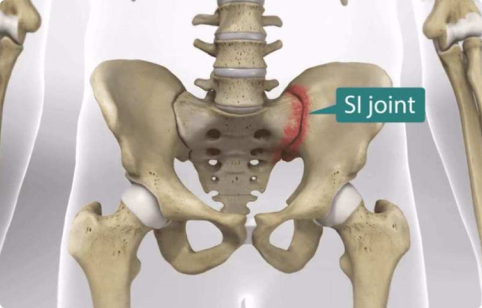Sacroiliitis or SI joint dysfunction is inflammation of one or more of the sacroiliac joints. The pain can be sharp or dull and usually begins at the lower back. The pain can spread to the buttocks, thighs, groin, or upper back area.
What Are the Symptoms of SI Joint Dysfunction?
SI joint dysfunction causes pain, mainly in the lower back and buttocks. The pain can often be triggered by standing and could be on one side or both sides of the buttocks.
Sacroiliitis pain can increase due to:
â— Standing for long periods
â— Running
â— Carrying weights
â— Taking large strides
Patients may also feel stiffness, instability, and a reduced range of motion of the lower back. The pain may be less noticeable while lying down.
What Causes SI Joint Dysfunction?
There are many factors that can lead to SI joint dysfunction. Some of the common ones include:
â— Physical trauma: Previous damage to the sacroiliac joints due to an accident or trauma can lead to inflammation of the joints.
â— Gait: Changes in gait can lead to uneven pressure on the joints, causing one of the joints to develop sacroiliitis.
â— Pregnancy: Pregnant women can have SI joint dysfunction as a consequence of carrying extra weight. The joints also need to loosen and tighten while going through childbirth. The altered gait can also contribute to SI joint dysfunction.
â— Arthritis: Osteoarthritis, a type of arthritis that occurs due to normal wear and tear of the cartilage, can cause SI joint problems. Furthermore, ankylosing spondylitis, another type of arthritis, that can cause some vertebrae to fuse together, can also lead to SI joint dysfunction.
â— Infection: An infection of the SI joints can also cause inflammation of the SI joints.
â— Repeated physical stress: Certain physical activities such as sports and weightlifting, puts regular stress on the joints. Over time, the joints could develop sacroiliitis.
â— Prior surgery: Some patients can develop SI joint dysfunction due to undergoing surgery. This is more common in patients who went through multiple surgical procedures of the spine.
How Is SI Joint Dysfunction Diagnosed?
Diagnosing sacroiliitis can be tricky as the symptoms may match with some other spinal disorders. Different tests may be used to isolate the affected area and rule out any possibilities of other illnesses.
Usually, the patient’s medical history is examined first, followed by a physical exam. The physician may then recommend certain tests:
â— Injections: The patient is injected with numbing injections (anesthetics), to verify if the SI joints are the source of the pain. If the injection to the joint reduces the pain, it is likely that the joints are the source of the pain.
â— Image testing: To ensure a proper diagnosis, a doctor may recommend imaging tests. These can include X-rays, CT scans, and MRIs of the lower back region.
What Is the Treatment for SI Dysfunction?
There are multiple approaches to treating SI joint dysfunction. Depending on the cause and the severity of pain, a doctor may recommend:
â— Rest: In very mild cases, resting for one or two days should be enough to relieve the pain.
â— Heat packs/ice packs: Applying hot packs help reduce muscle spasms. Ice packs reduce inflammation. A combination of the two may be applied to relieve pain.
â— Medications: Over the counter medicines such as anti-inflammatory medicines can help with the pain. However, in case of severe pain, a doctor may prescribe more potent medicines.
â— Therapy: Visiting a physical therapist or chiropractor can be very helpful in cases of SI joint dysfunction caused by little motion.
â— Surgery: If all other procedures fail to relieve symptoms, surgical methods may be used. These include joint injections to reduce inflammation and pain, radiofrequency denervation, and electrical stimulation. In some cases, a joint fusion can also be suggested. In this procedure, the bones are merged together using metal to treat SI joint dysfunction.

